Its a sustainable solution
While more people have begun to turn to sustainable solutions for heating to protect the environment, few understand how an air source heat pump works to generate energy. Here, we’ll answer the question of “How do air source heat pumps work?”
The Science Made Simple
An air source heating system functions using the principle of vapour compression, transferring hot air from one location to another throughout a home. The technology is like a refrigerator, which extracts heat from inside and pumps it outside to keep food cool. Air heating pumps work in the opposite way, extracting air from the outside and pumping it into a home. Like a refrigerator, air source heat pumps need electricity to run, but they use less energy than they produce. In winter months, an air source heating system can extract heat from atmospheres as cold as -15° C.
The Two Types of Air Source Heat Pump
There are two main types of heat pump:
1. Air-to-water heat pumps: These systems extract heat from the outside air and feed it into a wet central heating system. Because the heat produced is often cooler than with a standard boiler, underfloor heating and larger radiators are often recommended.

2. Air-to-air heat pumps: These systems extract heat from the outside air and push it through home fans. This system cannot heat water.

The Components of an Air Source Heat Pump
Air source pumps include four primary elements that transform the refrigerant within from a liquid state into a gas state. These elements are:
- The compressor
- The condenser
- The expansion valve
- The evaporator
The liquid refrigerant within the system passes through a high temperature of around 100 degrees or more, which transforms it into a gas or vapor. The energy created produces heat, and the heated gas moves through the compressor, which further increases the temperature. The hot vapor moves into the expansion valve, which moves the air around the building, before it moves back into a condenser which transforms the gas into a liquid again. After each cycle, the process starts afresh until the air source pump is switched off.
What Makes Air Heating Pumps Renewable?
Some people assume that air source heating pumps are not as sustainable as they claim to be because they still use electricity. However, these heating systems are renewable because they have access to an unlimited supply of heat stored in the outside air.
Perhaps even more importantly, the amount of energy that needs to be used to transfer heat around the home is much lower than the energy produced. Air source heat pumps have a COP of 3:1. For every 3 Kwh produced, only 1 Kwh is used.
Important Tips to Know about an Air Source Pump
- Air-to-water heat pumps often work better when installed with underfloor heating systems. This means that they can be ideal for placement in new buildings. If underfloor heating isn’t possible, large radiators can be effective. This is because the heat generated by an air source pump is not as high as that produced by conventional boilers. Larger surface areas are required to achieve wide-spread temperatures.
- Heat pumps can save property owners more on their heating bills when they replace electric, coal, oil, or LPG systems. However, a well-insulated house is essential, otherwise the heat generated by the pump can escape too easily.
- Air source heating pumps can reduce your carbon footprint, and make you eligible for government financial schemes.







